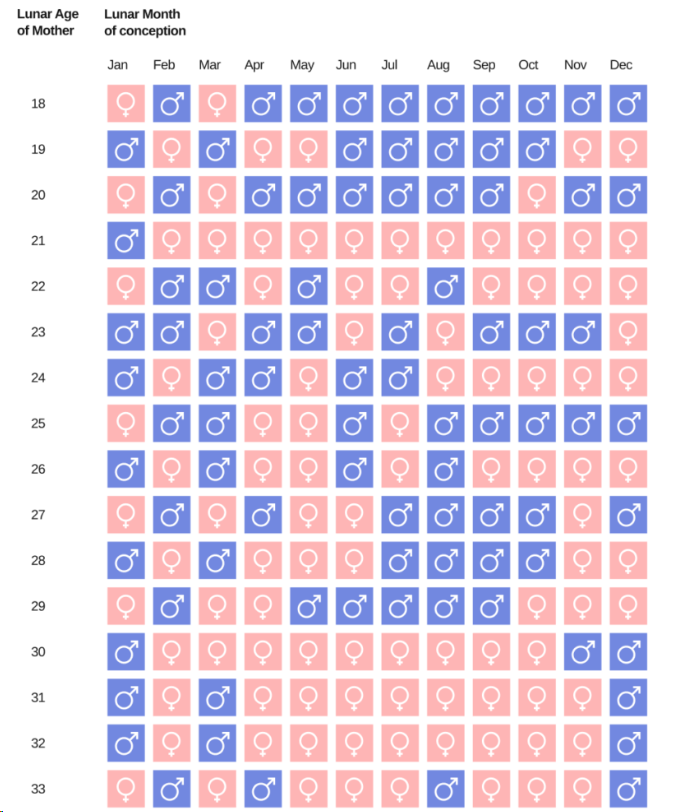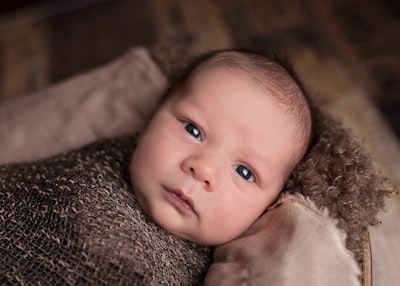The Chinese baby calendar gender predictor, a centuries-old tradition rooted in lunar calculations, has gained renewed interest among expectant parents for 2024. As reported by various sources, this ancient method claims to forecast a baby’s gender based on the mother’s lunar age and conception month, offering a blend of cultural intrigue and speculative fun for those eagerly awaiting their new arrivals.

Historical Origins of the Chart
The Chinese baby gender prediction chart, steeped in ancient tradition, has a fascinating and somewhat mysterious history. According to legend, the chart originated over 700 years ago during the Qing Dynasty (1644-1912) in China.
It was purportedly discovered in a royal tomb, suggesting its importance to the imperial family.
The chart’s creation is attributed to scientists in the imperial court, who developed it using principles from I Ching (易經), which incorporates concepts of Yin and Yang, the Five Elements, and the Eight Trigrams. Initially, its primary purpose was to help royal families predict and potentially select the gender of their children, with a particular emphasis on producing male heirs to continue the imperial lineage.
One elaborate version of the chart’s history claims that it disappeared from the Summer Palace of Emperor Guangxu in 1900, following China’s defeat in the war with the Eight-Nation Alliance. The chart was then allegedly sent to England, where it was kept as a treasured artifact by the British monarchy.
In a twist of fate, the chart resurfaced in Austria in 1972 under unclear circumstances. A Chinese historian reportedly discovered it there, copied its contents, and published them in a Taiwanese newspaper. This event marked the chart’s transition from a closely guarded imperial secret to a widely accessible tool.Since its rediscovery, the Chinese gender prediction chart has been published annually in the Chinese Farmers’ Almanac and has become available in delivery rooms of Chinese hospitals. This widespread dissemination has contributed to its popularity both within China and internationally.
It’s important to note that while these historical accounts are intriguing, they are largely based on legend and oral tradition. The exact origins of the chart remain shrouded in mystery, with multiple versions of its history circulating. Despite the lack of concrete historical evidence, the chart’s enduring popularity and cultural significance are undeniable, reflecting its deep roots in Chinese tradition and its appeal to expectant parents worldwide.
Lunar Age Calculation Explained
Lunar age calculation is a fundamental aspect of using the Chinese baby gender predictor chart. Unlike the Gregorian calendar used in most Western countries, the Chinese lunar calendar forms the basis for determining one’s lunar age, which is essential for accurate predictions.The lunar age system differs significantly from the solar age system in several key ways:
- Starting age: In the lunar system, a person is considered to be one year old at birth, rather than zero.
- Age incrementation: Lunar age increases by one year on each Chinese New Year, not on one’s birthday.
To calculate your lunar age:
- Determine the current year in the Chinese lunar calendar.
- Find out your birth year in the Chinese lunar calendar.
- Apply the formula: Lunar Age = Current Year (lunar) – Birth Year (lunar) + 1.
For example, if you were born in the Year of the Rat (1984) and the current lunar year is the Year of the Dragon (2024), your lunar age would be:
2024 – 1984 + 1 = 41
It’s important to note that if the current date is before the Chinese New Year, you should add one more year to your calculated age, as the new lunar year hasn’t begun yet.
The lunar age calculation can sometimes result in a person being one or two years older than their solar age. This is due to the difference in starting age (1 vs. 0) and the fact that age increases on New Year rather than birthdays.
For the Chinese baby gender predictor, it’s crucial to use the mother’s lunar age at the time of conception, not her current age or solar age. This requires converting both the mother’s birth date and the conception date to the lunar calendar.
Online lunar age calculators are available to simplify this process, but understanding the underlying principles helps in appreciating the cultural significance of this age reckoning system.
While the lunar age system may seem complex to those accustomed to the solar calendar, it reflects the deep-rooted cultural practices and beliefs of Chinese tradition. This system acknowledges the time spent in the womb and the cyclical nature of the lunar calendar, aspects that are integral to the philosophy behind the Chinese baby gender predictor.
Cultural Significance in Modern Times
The Chinese baby gender predictor, despite its lack of scientific basis, continues to hold significant cultural importance in modern times. This enduring popularity reflects the complex interplay between tradition and contemporary society, particularly in China and among Chinese communities worldwide.
In China, where the predictor originated, it remains a widely consulted tool among expectant parents. This persistence is partly due to the deep-rooted cultural preference for male children, a legacy of China’s patriarchal society and the now-abolished one-child policy. While attitudes are changing, the gender predictor still serves as a focal point for family discussions and planning.
Interestingly, the predictor has gained traction beyond Chinese borders. In many Western countries, it has become a popular “old wives’ tale” method for gender prediction, often used alongside other non-scientific methods like the ring test or pregnancy cravings. This global appeal speaks to a universal fascination with predicting a baby’s gender, transcending cultural boundaries.
The predictor’s significance extends beyond mere curiosity. For some, it serves as a way to connect with Chinese cultural heritage. Diaspora communities, in particular, may use the predictor as a means of maintaining ties to their ancestral traditions, even if they don’t fully believe in its accuracy.
In the age of social media, the Chinese gender predictor has found new life. Expectant parents often share their predictions online, creating a sense of community and shared excitement. This digital proliferation has contributed to the predictor’s continued relevance in modern pregnancy culture.
However, the predictor’s popularity also raises ethical concerns. In some cases, it may reinforce gender stereotypes or even influence decisions about family planning. Healthcare professionals often caution against placing too much emphasis on these predictions, stressing the importance of valuing children regardless of gender.
The predictor has also become a point of interest in discussions about cultural appropriation and the commercialization of traditional practices. As it gains popularity in non-Chinese contexts, questions arise about the respectful use and understanding of its cultural origins.
Despite these complexities, the Chinese baby gender predictor remains a fascinating intersection of ancient wisdom and modern curiosity. Its enduring appeal in 2024 demonstrates how traditional practices can adapt and find new meaning in contemporary society, serving as a bridge between past and present, and between different cultures around the world.
Concluding Thoughts
The Chinese baby gender predictor, while rooted in ancient traditions, remains a popular cultural phenomenon in 2024. Despite its lack of scientific validity, as evidenced by a study showing its accuracy to be no better than chance, the predictor continues to captivate expectant parents worldwide. Its enduring appeal lies in its blend of cultural heritage, mystique, and the universal excitement surrounding pregnancy.Key takeaways:
- The predictor is best viewed as an entertaining tradition rather than a reliable method for gender determination.
- Modern medical techniques, such as ultrasounds and genetic testing, remain the most accurate ways to determine fetal sex.
- The predictor’s popularity highlights the ongoing fascination with blending ancient wisdom and modern pregnancy experiences.
- While fun to use, it’s crucial for expectant parents to approach the predictor with a healthy dose of skepticism and not base important decisions on its results.
Ultimately, the Chinese baby gender predictor for 2024 serves as a cultural bridge, connecting past and present, and offering a moment of lighthearted speculation during the journey of pregnancy.
Frequently Asked Questions
How accurate is the Chinese baby gender predictor for 2024?
Despite claims of high accuracy, scientific studies show the predictor is no more accurate than random guessing, with a 50% success rate. It should be viewed as entertainment rather than a reliable method.
Can the Chinese calendar be used to plan for a specific gender?
While some believe it can be used for gender selection, there’s no scientific evidence supporting this. Ethical concerns arise from attempting to choose a baby’s gender based on cultural preferences.
Does the father’s age or birth date affect the prediction?
No, the Chinese gender predictor only considers the mother’s lunar age and conception month.
How does the lunar calendar affect predictions for 2024?
The lunar calendar may include a leap month in some years, which can complicate predictions. Some sources suggest splitting the leap month between adjacent months for prediction purposes.
Are there different versions of the Chinese gender predictor chart?
Yes, multiple versions exist online. However, proponents claim there’s only one authentic chart, and variations may lead to inconsistent predictions.
Can the predictor be used for multiple pregnancies?
The traditional chart doesn’t account for multiple pregnancies. Its effectiveness for twins or triplets is unclear and not scientifically validated.
